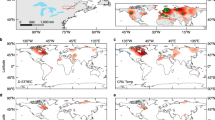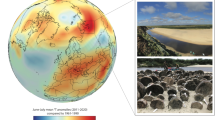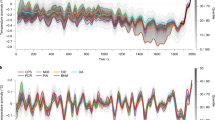Abstract
The largest eruption of a tropical volcano during the past millennium occurred in AD 1258–1259. Its estimated radiative forcing was several times larger than the 1991 Pinatubo eruption1. Radiative forcing of that magnitude is expected to result in a climate cooling of about 2 °C (refs 2, 3, 4, 5). This effect, however, is largely absent from tree-ring reconstructions of temperature6,7,8, and is muted in reconstructions that employ a mix of tree-rings and other proxy data9,10. This discrepancy has called into question the climate impact of the eruption2,5,11. Here we use a tree-growth model driven by simulated temperature variations to show that the discrepancy between expected and reconstructed temperatures is probably an artefact caused by a reduced sensitivity to cooling in trees that grow near the treeline. This effect is compounded by the secondary effects of chronological errors due to missing growth rings and volcanically induced alterations of diffuse light. We support this conclusion with an assessment of synthetic proxy records created using the simulated temperature variations. Our findings suggest that the evidence from tree rings is consistent with a substantial climate impact2,3,4,5 of volcanic eruptions in past centuries that is greater than that estimated by tree-ring-based temperature reconstructions.
This is a preview of subscription content, access via your institution
Access options
Subscribe to this journal
Receive 12 print issues and online access
$259.00 per year
only $21.58 per issue
Buy this article
- Purchase on Springer Link
- Instant access to full article PDF
Prices may be subject to local taxes which are calculated during checkout



Similar content being viewed by others
References
Jones, P. D. & Mann, M. E. Climate over past millennia. Rev. Geophys. 42, RG2002 (2004).
Robock, A. Cooling following large volcanic eruptions corrected for the effect of diffuse radiation on tree rings. Geophys. Res. Lett. 32, L06702 (2005).
Ammann, C. M. et al. Solar influence on climate during the past millennium: Results from transient simulations with the NCAR Climate System Model. Proc. Natl Acad. Sci. 104, 3713–3718 (2007).
Gao, C., Robock, A. & Ammann, C. Volcanic forcing of climate over the past 1500 years: An improved ice core-based index for climate models. J. Geophys. Res. 113, D23111 (2008).
Timmreck, C. et al. Limited temperature response to the very large AD 1258 volcanic eruption. Geophys. Res. Lett 36, L21708 (2009).
Esper, J., Cook, E. R. & Schweingruber, F. H. Low-frequency signals in long tree-ring chronologies for reconstructing past temperature variability. Science 295, 2250–2253 (2002).
D’Arrigo, R., Wilson, R. & Jacoby, G. On the long-term context for late twentieth century warming. J. Geophys. Res 111, D03103 (2006).
Briffa, K. R. et al. Trends in recent temperature and radial tree growth spanning 2000 years across northwest Eurasia. Phil. Trans. R. Soc. B 363, 2269–2282 (2008).
Jansen, E. et al. in IPCC Climate Change 2007: The Physical Science Basis (eds Solomon, S. et al.) (Cambridge Univ. Press, 2007).
Mann, M. E. et al. Proxy-based reconstructions of hemispheric and global surface temperature variations over the past two millennia. Proc. Natl Acad. Sci. USA 105, 13252–13257 (2008).
Salzer, M. W. & Hughes, M. K. Bristlecone pine tree rings and volcanic eruptions over the last 5,000 yr. Quat. Res. 67, 57–68 (2007).
North, G. R., Cahalan, R. F. & Coakley, J. A. Energy balance climate models. Rev. Geophys. 19, 91–121 (1981).
Crowley, T. J. Causes of climate change over the past 1000 years. Science 289, 270–277 (2000).
Kennedy, J. J. et al. Reassessing biases and other uncertainties in sea-surface temperature observations since 1850 part 2: biases and homogenisation. J. Geophys. Res (in the press).
Mann, M. E. et al. Testing the fidelity of methods used in proxy-based reconstructions of past climate. J. Clim. 18, 4097–4107 (2005).
Shashkin, A. V. & Vaganov, E. A. Simulation model of climatically determined variability of conifers’ annual increment (on the example of common pine in the steppe zone). Russ. J. Ecol 24, 275–280 (1993).
Evans, M. N. et al. A forward modeling approach to paleoclimatic interpretation of tree-ring data. J Geophys. Res. 111, G03008 (2006).
Gu, L. et al. Response of a deciduous forest to the Mount Pinatubo eruption: Enhanced photosynthesis. Science 299, 2035–2038 (2003).
MacDonald, G. M., Kremenetski, K. V. & Beilman, D. W. Climate change and the northern Russian treeline zone. Phil. Trans. R. Soc. Lond. B 363, 2285–2299 (2008).
Rossi, S. et al. Evidence of threshold temperatures for xylogenesis in conifers at high altitudes. Oecologia 152, 1–12 (2007).
Hughes, M. K. & Ammann, C. M. The future of the past—an earth system framework for high resolution paleoclimatology: Editorial essay. Climatic Change 94, 247–259 (2009).
Goosse, H. et al. Using paleoclimate proxy-data to select optimal realisations in an ensemble of simulations of the climate of the past millennium. Clim. Dynam. 27, 165–184 (2006.).
McGuffie, K. & Henderson-Sellers, A. A Climate Modeling Primer 2nd edn (Wiley, 1997).
IPCC Climate Change 2007: The Physical Science Basis (eds Solomon, S. et al.) (Cambridge Univ. Press, 2007).
Brohan, P. et al. Uncertainty estimates in regional and global observed temperature changes: a new dataset from 1850. J. Geophys. Res. 111, D12106 (2006).
Acknowledgements
M.E.M. acknowledges support from the ATM program of the National Science Foundation (grant ATM-0902133). J.D.F. acknowledges support from the DOE (grant DE-FC02-06ER64298). We thank L. Ning and S. Miller for providing technical assistance.
Author information
Authors and Affiliations
Contributions
M.E.M. carried out the modelling work. J.D.F. provided input on the biological modelling. S.R. assisted with the pseudoproxy tests. M.E.M. primarily wrote the paper. All three authors discussed results and provided input on the manuscript.
Corresponding author
Ethics declarations
Competing interests
The authors declare no competing financial interests.
Supplementary information
Supplementary Information
Supplementary Information (PDF 2673 kb)
Rights and permissions
About this article
Cite this article
Mann, M., Fuentes, J. & Rutherford, S. Underestimation of volcanic cooling in tree-ring-based reconstructions of hemispheric temperatures. Nature Geosci 5, 202–205 (2012). https://doi.org/10.1038/ngeo1394
Received:
Accepted:
Published:
Issue Date:
DOI: https://doi.org/10.1038/ngeo1394
This article is cited by
-
Climate warming is significantly influenced by rising summer maximum temperatures: insights from tree-ring evidence of the Western Tianshan Mountains, China
Journal of Forestry Research (2024)
-
Impacts of major volcanic eruptions over the past two millennia on both global and Chinese climates: A review
Science China Earth Sciences (2024)
-
A Review of El Niño Southern Oscillation Linkage to Strong Volcanic Eruptions and Post-Volcanic Winter Warming
Earth Systems and Environment (2023)
-
If a tree grows no ring and no one is around: how scientists deal with missing tree rings
Climatic Change (2022)
-
Global tree-ring response and inferred climate variation following the mid-thirteenth century Samalas eruption
Climate Dynamics (2022)



